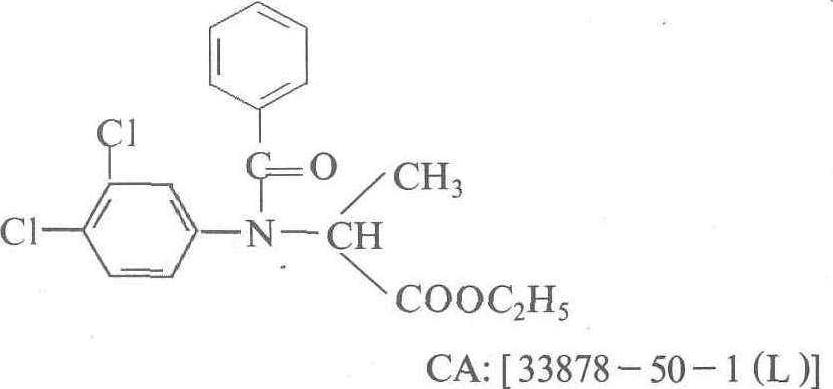新燕灵benzoylprop-ethyl
苗后选择性野燕麦酰胺类除草剂。又名新燕胺、Suffix。化学结构式:

性能 原药为灰白色粉末,熔点70~71℃。水中溶解度为20毫克/升(25℃),丙酮中溶解度为70~75%。对光稳定,在中性溶液中稳定,但在酸性和碱性溶液中能缓慢分解。对高等动物低毒。大鼠急性口服LD50为1555毫克/千克。小鼠急性经皮LD50>1000毫克/千克。野鸭和家禽急性经口LD50分别大于200、1000毫克/千克。通过叶子吸收后,向杂草其他部分转移,并且很快分解成对其有毒的酰乙基酸,积累到一定浓度后就能抑制野燕麦细胞的伸长;但在作物体内,酰乙基酸进一步和糖结合成无毒化合物。
应用 主要用于小麦、大麦、油菜、甜菜等作物中防治野燕麦,对看麦娘属杂草也有效。❶小麦地除草。在干旱地区,小麦苗返青至开始拔节、野燕麦大部出苗时,每公顷用20%新燕灵乳油5~7升,对水均匀喷雾。3天后野燕麦开始出现中毒症状,15天后枯心苗增多,直至枯死。持效期约30天。小麦出现3个茎节时处理易发生药害。
❷油菜地除草。在油菜茎伸长阶段,用20%新燕灵乳油5~7升/公顷,进行叶面喷洒,对冬播或春播油菜地中野燕麦有良好防效。
❸甜菜3~4叶时(野燕麦4~6叶),用新燕灵每公顷4.5~7升,均匀喷洒叶面,能有效地抑制野燕麦生长。燕麦、亚麻、番茄等作物敏感,应防止药雾飘移引起伤害。
新燕灵benzoylpropethly
又称新燕胺。酰胺类内吸选择性除草剂。化学名称:N-苯甲酰基-N-(3,4-二氯苯基)-二氨基丙酸乙酯。化学结构式如下。原药为灰白色结晶粉末,熔点70~71℃,20℃时蒸气压为466.6×10-8 Pa。几乎不溶于水,易溶于丙酮。中性溶液中稳定,在酸和碱性溶液中缓慢分解,对光稳定。药剂可通过叶面吸收,抑制细胞分裂,杀死野燕麦或抑制生长,不能抽穗结实。结实种子大多丧失发芽能力。在小麦等植物体内可形成无毒的糖轭合物。适用防除于小麦、油菜、蚕豆等作物中的野燕麦。对人、畜低毒,大鼠急性口服LD50为1 555 mg/kg,急性经皮LD50>1 000 mg/kg。
